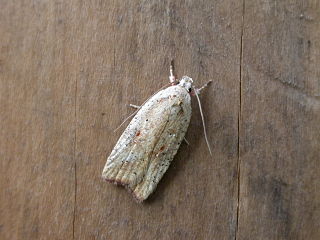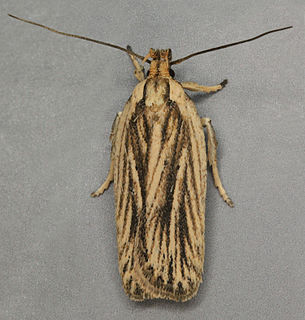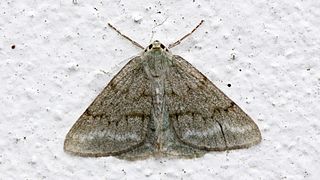
Ulex is a genus of flowering plants in the family Fabaceae. The genus comprises about 20 species of thorny evergreen shrubs in the subfamily Faboideae of the pea family Fabaceae. The species are native to parts of western Europe and northwest Africa, with the majority of species in Iberia.

Oecophoridae is a family of small moths in the superfamily Gelechioidea. The phylogeny and systematics of gelechoid moths are still not fully resolved, and the circumscription of the Oecophoridae is strongly affected by this.

The green hairstreak is a small butterfly in the family Lycaenidae.

Ulex europaeus is a species of flowering plant in the family Fabaceae, native to the British Isles and Western Europe.
NVC community H2 is one of the heath communities in the British National Vegetation Classification system. It is one of five communities categorised as lowland dry heaths.

Ulex gallii, western gorse or dwarf furze is an evergreen shrub in the pea family (Fabaceae), native to the Atlantic coasts of western Europe: southern Scotland, England, Wales, Ireland, the Isle of Man, western France and the northern coast of Spain.

Cydia succedana, or Gorse Pod Moth is a species of moth of the family Tortricidae. It is found in Europe and has been introduced to New Zealand.

The gorse tip moth is a smallish moth species of the family Depressariidae.

Uresiphita gilvata is a moth of the family Crambidae. It was first described by Johan Christian Fabricius in 1794 and is found in Europe and North Africa.
Cydia medicaginis, the alfalfa moth, is a moth of the family Tortricidae. It is found in northern and central Europe, Transcaucasus, Kazakhstan and from western Russia to southern Siberia.

Anarsia spartiella, the Wanstead grey, is a moth of the family Gelechiidae. It is found in most of Europe.

Agonopterix umbellana is a moth of the family Depressariidae. It is native to western Europe, but was introduced to Hawaii in 1988 and New Zealand in 1990 to control Ulex europaeus.

Chlorissa viridata, the small grass emerald, is a moth of the family Geometridae. The species was first described by Carl Linnaeus in his 1758 10th edition of Systema Naturae. It is found from western Europe to the eastern Palearctic.

Blastodacna atra, the apple pith moth is a moth of the family Elachistidae. It is known from most of Europe and it has been introduced to North America.

Pseudoterpna coronillaria, the Jersey emerald or gorse emerald, is a moth of the family Geometridae. The species was first described by Jacob Hübner in 1796. It is known from Spain, Portugal, the Pyrenees, western and southern France, Corsica, Sardinia, Sicily, Italy, Samos, Rhodes, Turkey, Israel, Lebanon, northern Jordan and North Africa. It has not been reported from mainland Great Britain, but is present on Jersey, where it was previously overlooked as a form of the grass emerald, until 2001 when it was correctly identified.
Coleophora saturatella is a moth of the family Coleophoridae. It is found from Sweden to the Pyrenees, the Alps and Albania and from Great Britain to Romania. It has also been recorded from southern Russia.

Coleophora ochrea is a moth of the family Coleophoridae found in Europe. It was first described by Adrian Hardy Haworth in 1828.

Brachmia blandella, the gorse crest, is a moth of the family Gelechiidae. It is found in most of Europe, except Ireland, Slovenia and Croatia. The habitat consists of woodland margins and heath.
Scythris fuscoaenea is a moth of the family Scythrididae found in Europe.

Scythris picaepennis is a moth of the family Scythrididae first described by Adrian Hardy Haworth in 1828. It is found in Europe.















